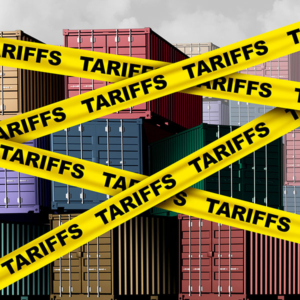
Monica Gorman, a White House special assistant for manufacturing and industrial policy during the Biden administration who now works at Crowell Global Advisors, spoke to JCK last Friday about what she’s telling clients about coping with the current landscape of tariffs and trade wars:
Is it at all possible to avoid the tariffs?
Continuing to diversify from China. But honestly, companies have been working on that for a while, and it’s easier for some than others. I’m certain that trend will continue, but it’s not as though that’s a new area of focus.
With the 10% tariffs, there’s not really a way to avoid those. They’re across the board at the moment.
In terms of what I’m advising clients, given the uncertainty, there’s a need to know your exposures, your risks, and where you have flexibility—whether it’s in your product mixes or manufacturing. Beyond that, it’s charting a path that’s best for your business because given all the volatility, predicting [what will happen] is not really possible right now.
The so-called reciprocal tariffs are “paused” for 90 days. Do you see them coming back?
Good question. The pause that we saw appears due to the unintended consequences in the economy, particularly the bond market. Memories of that are going to remain.
The president has signaled he wants to do trade deals over the next 90 days. I think we will see negotiations, but as someone who’s worked in policy and spent time a lot of time in government, it will be very difficult to negotiate bespoke trade deals with 100 countries in 90 days, particularly if you’re looking at complex issues like non-tariff barriers. This is going to create a lot of uncertainty in the next three months.
Regarding China, the current tariff rate is 145%. Will people actually pay that?
We are in an escalating trade war with China. It’s been a tit-for-tat, and the off-ramp is not clear. We saw in the first Trump administration that ultimately there was a desire for negotiations and getting a deal done. So if history is any guide, perhaps that’s where we go this time around. But the world is also different politically. Post-COVID, both countries are in a different place. Right now it’s just unknown.
[The tariffs] will basically close off trade with both countries. U.S. exports will no longer be competitive in China. With China, the reality is there are certain types of products that we can’t get from anywhere else. They may not be finished goods, but there are certainly components. Some prices will go up because of the tariffs, since there aren’t any alternative options.
One question I’ve heard is What’s happening with Canada?
Tariffs are 25%, but USMCA [United States-Mexico-Canada Agreement]-compliant goods are exempt.
Is jewelry considered a compliant good?
That depends on what piece you’re talking about and which tariff code it’s coming in under and whether or not the paperwork has been submitted accordingly.
How do you know if a piece is compliant or not?
That’s something anybody who’s been trading under USMCA should know.
Do you expect the 10% tariff worldwide to have an impact on consumer prices?
It’s certainly going to create inflationary pressures. We are reliant on imported goods in many sectors. Even U.S. manufacturers typically import materials and components, and all of those just got more expensive. That will drive up prices, including for U.S.-manufactured goods.
Will the whole 10% be passed along to consumers?
That’s going to be really industry-specific, based on how much flexibility there is along the supply chain to absorb some of those costs. They won’t all necessarily be passed along to the consumer, but it’s hard to see how this doesn’t have inflationary impacts.
Do you think implementation of the tariffs will lead to an increase in American manufacturing?
The emphasis on U.S. manufacturing goes back a few years, along with a renewed emphasis on industrial policy and making more things in the United States, and diversifying supply chains to ensure that key products are not dependent on one country or a couple of suppliers in one part of the world. Because things happen, natural disasters happen. I do think that the emphasis on U.S. manufacturing and broader supply chain resilience can, and frankly should, continue. But it can’t be for every industry and every product in every industry across the board. My hope is that there will be some prioritization of the industries where we should lean into U.S. manufacturing, and also where it might be better to think more broadly about working with allies and partners.
There are questions about how Customs will treat items that are imported into the United States for a limited time but not sold here, such as gemstones submitted for grading. I know importers can get a temporary importation under bond (TIB) exemption, but is there a way that can be made easier?
Unfortunately, there’s no formal process right now to seek broad exemptions for the IEEPA [International Emergency Economic Powers Act] tariffs, but companies can try to make their case directly to administration officials for consideration.
What do you recommend to people who are affected by these tariffs?
What we haven’t seen is, really, the voice of business in these negotiations. I’m encouraging clients to speak up and find a way to make their voices heard about the impact to their businesses. That’s particularly true for small businesses who may not have deep Washington roots, who may not know folks in the White House, but they need to find ways through associations and other means to make sure that their voices are heard and considered.
It’s important for Main Street to speak up right now about how these policy actions are impacting them.
A lot of industries are likely to step up their lobbying. How effective will lobbying be with so much happening on trade?
Advocacy is going to be important here. For jewelry, some countries in Africa were hit hard by the original reciprocal-tariff list. The foreign policy considerations for Africa are very different than they are for other parts of the world.
I’m advising clients to think about their sourcing priorities, and where there are things like rough gemstones that you cannot get in other parts of the world. Then think about advocates. If you take the countries of Africa, there’s champions on the Hill for AGOA [the African Growth and Opportunity Act.]
Think about foreign policy priorities. We know China plays in a big way in Africa. Is there a way to start conversations with people on Capitol Hill and in the administration? Lesotho and Botswana are not ripping the United States off, even though they were subject to very high tariffs. That’s because of trade deficits due to where those countries are. It’s possible to have focused discussions about particular countries that may be a priority to the industry.
What effect has all this had on exports?
I’ve not personally observed anything. In the last week, there’s been so much whiplash that I suspect most have responded with paralysis, trying to figure out what’s going on but not making major business decisions yet.
(Credit: Getty Images)
- Subscribe to the JCK News Daily
- Subscribe to the JCK Special Report
- Follow JCK on Instagram: @jckmagazine
- Follow JCK on X: @jckmagazine
- Follow JCK on Facebook: @jckmagazine






